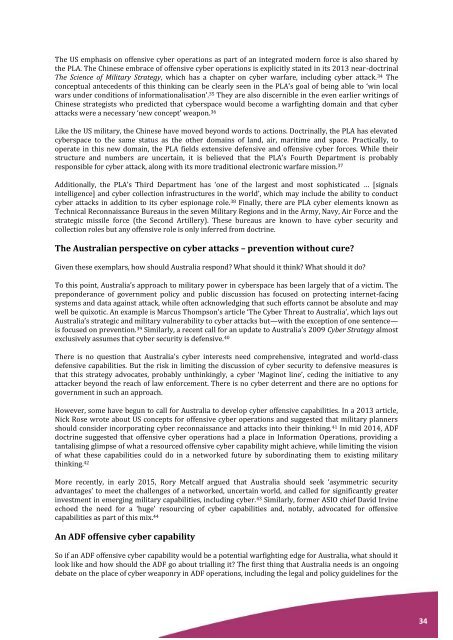Issue No 198 2015
198 2015 Nov_Dec
198 2015 Nov_Dec
Create successful ePaper yourself
Turn your PDF publications into a flip-book with our unique Google optimized e-Paper software.
The US emphasis on offensive cyber operations as part of an integrated modern force is also shared by<br />
the PLA. The Chinese embrace of offensive cyber operations is explicitly stated in its 2013 near-doctrinal<br />
The Science of Military Strategy, which has a chapter on cyber warfare, including cyber attack. 34 The<br />
conceptual antecedents of this thinking can be clearly seen in the PLA’s goal of being able to ‘win local<br />
wars under conditions of informationalisation’. 35 They are also discernible in the even earlier writings of<br />
Chinese strategists who predicted that cyberspace would become a warfighting domain and that cyber<br />
attacks were a necessary ‘new concept’ weapon. 36<br />
Like the US military, the Chinese have moved beyond words to actions. Doctrinally, the PLA has elevated<br />
cyberspace to the same status as the other domains of land, air, maritime and space. Practically, to<br />
operate in this new domain, the PLA fields extensive defensive and offensive cyber forces. While their<br />
structure and numbers are uncertain, it is believed that the PLA’s Fourth Department is probably<br />
responsible for cyber attack, along with its more traditional electronic warfare mission. 37<br />
Additionally, the PLA’s Third Department has ‘one of the largest and most sophisticated … [signals<br />
intelligence] and cyber collection infrastructures in the world’, which may include the ability to conduct<br />
cyber attacks in addition to its cyber espionage role. 38 Finally, there are PLA cyber elements known as<br />
Technical Reconnaissance Bureaus in the seven Military Regions and in the Army, Navy, Air Force and the<br />
strategic missile force (the Second Artillery). These bureaus are known to have cyber security and<br />
collection roles but any offensive role is only inferred from doctrine.<br />
The Australian perspective on cyber attacks – prevention without cure?<br />
Given these exemplars, how should Australia respond? What should it think? What should it do?<br />
To this point, Australia’s approach to military power in cyberspace has been largely that of a victim. The<br />
preponderance of government policy and public discussion has focused on protecting internet-facing<br />
systems and data against attack, while often acknowledging that such efforts cannot be absolute and may<br />
well be quixotic. An example is Marcus Thompson’s article ‘The Cyber Threat to Australia’, which lays out<br />
Australia’s strategic and military vulnerability to cyber attacks but—with the exception of one sentence—<br />
is focused on prevention. 39 Similarly, a recent call for an update to Australia's 2009 Cyber Strategy almost<br />
exclusively assumes that cyber security is defensive. 40<br />
There is no question that Australia's cyber interests need comprehensive, integrated and world-class<br />
defensive capabilities. But the risk in limiting the discussion of cyber security to defensive measures is<br />
that this strategy advocates, probably unthinkingly, a cyber ‘Maginot line’, ceding the initiative to any<br />
attacker beyond the reach of law enforcement. There is no cyber deterrent and there are no options for<br />
government in such an approach.<br />
However, some have begun to call for Australia to develop cyber offensive capabilities. In a 2013 article,<br />
Nick Rose wrote about US concepts for offensive cyber operations and suggested that military planners<br />
should consider incorporating cyber reconnaissance and attacks into their thinking. 41 In mid 2014, ADF<br />
doctrine suggested that offensive cyber operations had a place in Information Operations, providing a<br />
tantalising glimpse of what a resourced offensive cyber capability might achieve, while limiting the vision<br />
of what these capabilities could do in a networked future by subordinating them to existing military<br />
thinking. 42<br />
More recently, in early <strong>2015</strong>, Rory Metcalf argued that Australia should seek ‘asymmetric security<br />
advantages’ to meet the challenges of a networked, uncertain world, and called for significantly greater<br />
investment in emerging military capabilities, including cyber. 43 Similarly, former ASIO chief David Irvine<br />
echoed the need for a ‘huge’ resourcing of cyber capabilities and, notably, advocated for offensive<br />
capabilities as part of this mix. 44<br />
An ADF offensive cyber capability<br />
So if an ADF offensive cyber capability would be a potential warfighting edge for Australia, what should it<br />
look like and how should the ADF go about trialling it? The first thing that Australia needs is an ongoing<br />
debate on the place of cyber weaponry in ADF operations, including the legal and policy guidelines for the<br />
34


